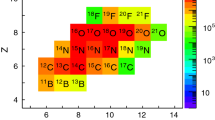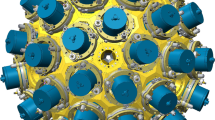Abstract
We demonstrate the possibility to extract nuclear state femtosecond lifetimes from two-step \(\gamma \) ray cascades measured with a Ge-detector array. The technique is based on measuring the Doppler shift of a \(\gamma \) ray, caused by the recoil of a preceding \(\gamma \) ray emission. Since the two \(\gamma \) rays are populating/de-populating the same state they form a start/stop signal, the delay of which is compared to the slowing down motion of the nucleus within the target material. A multi-detector array combined with digital acquisition electronics in list mode, allows to measure several angular combinations and two-step cascades efficiently and simultaneously within one single experiment. The concept was demonstrated with the FIPPS array for the \(^{35}\hbox {Cl(n,}\gamma \hbox {)}^{36}\hbox {Cl}\) reaction, where we obtained good agreement with literature values showing the validity of the method.







Similar content being viewed by others
Data Availability Statement
This manuscript has associated data in a data repository. [Authors’ comment: The reference to the data is already included in the references of the paper as DOI].
References
J.M. Regis, M. Dannhoff, J. Jolie, Nucl. Instrum. Methods A 897, 38 (2018)
P.J. Nolan, J.F. Sharpey-Schafer, Rep. Prog. Phys. 42, 1 (1979)
A. Dewald et al., Prog. Part. Nucl. Phys. 67, 786 (2012)
P. Petkov et al., Nucl. Instrum. Methods A 560, 564 (2006)
T.K. Alexander, J.S. Forster, Adv. Nucl. Phys. 10, 197 (1978)
T. Belgya et al., Nucl. Phys. A 607, 43 (1996)
H.G. Börner, J. Jolie, J. Phys. G 19, 217 (1993)
E.G. Kessler et al., Nucl. Instrum. Methods A 457, 187 (2001)
C. Michelagnoli et al., EPJ Web Conf. 193, 04009 (2018)
V.T. Kupryashkin et al., AN SSSR Ser. Fiz. 53, 2 (1989)
T. Kahn et al., Nucl. Instrum. Methods A 385, 100 (1997)
V. Egorov et al., Nucl. Phys. A 621, 745 (1997)
Private Communication with C. Michelagnoli and J. Jolie
S. Agostinelli et al., Nucl. Instrum. Methods A 506, 250 (2003)
M. Meyer, V. Pontikis, Computer simulation in materials science: interatomic potentials. In Techniques and Applications, Proceedings of ASI (Kluwer Academic Publishers, Aussois, 1991)
S. Ulbig et al., Phys. Lett. B 259, 29 (1991)
A. Kuronen et al., Nucl. Phys. A 549, 59 (1992)
M. Jentschel et al., Nucl. Instrum. Methods B 115, 446 (1996)
https://www.nndc.bnl.gov/ensdf/. Accessed 25 Jan 2020
C.R.A. Catlow et al., J. Phys. C 10, 1395 (1977)
J.F. Ziegler, J.P. Biersack, U. Littmark, The Stopping and Range of Ions in Solids (Pergamon Press, New York, 1985)
J.F. Ziegler, J.P. Biersack, M.D. Ziegler, SRIM—the stopping and range of ions in matter (SRIM Co. ISBN 978-0-9654207-1-6. 2008) (2008)
W. Wilson et al., Phys. Rev. B 15, 2458 (1977)
https://root.cern.ch/. Accessed 25 Jan 2020
Information extracted from the NuDat 2 database. http://www.nndc.bnl.gov/nudat2/. Accessed 25 Jan 2020
N. Cieplicka-Oryńczak et al., Acta Phys. Pol. B 49, 561 (2018)
J.A.J. Hermans et al., Nucl. Phys. A 284, 307 (1977)
A.S. Yousef et al., Phys. Rev. C 8, 684 (1973)
E.K. Warburton, Phys. Rev. C 7, 1120 (1973)
Author information
Authors and Affiliations
Corresponding author
Additional information
Communicated by Calin Alexandru Ur.
Rights and permissions
About this article
Cite this article
Crespi, F.C.L., Cieplicka-Oryńczak, N., Jentschel, M. et al. GRIDSA: femtosecond lifetime measurements with germanium detector arrays. Eur. Phys. J. A 56, 94 (2020). https://doi.org/10.1140/epja/s10050-020-00088-x
Received:
Accepted:
Published:
DOI: https://doi.org/10.1140/epja/s10050-020-00088-x




